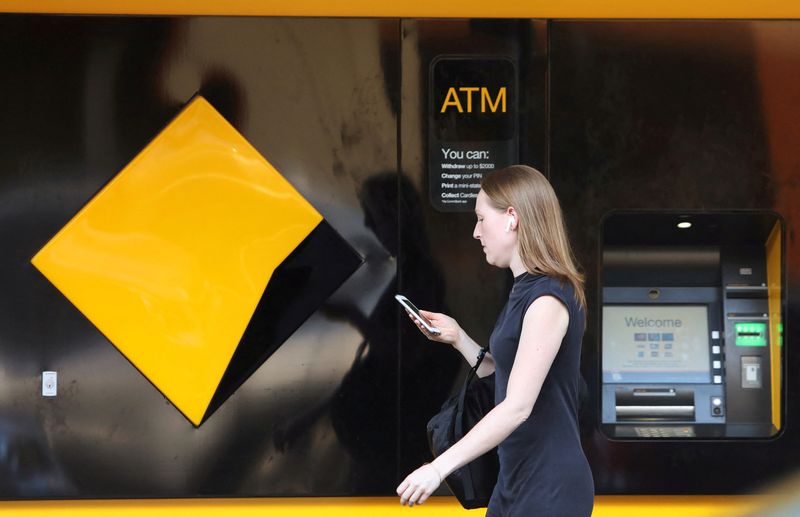
© Reuters. FILE PHOTO: A woman walks past a Commonwealth Bank of Australia logo and ATM in Sydney, Australia, February 7, 2018. REUTERS/Daniel Munoz/File Photo
CBA
-0.44%
Add to/Remove from Watchlist
Add to Watchlist
Add Position
Position added successfully to:
Please name your holdings portfolio
Type:
BUY
SELL
Date:
Amount:
Price
Point Value:
Leverage:
1:1
1:10
1:25
1:50
1:100
1:200
1:400
1:500
1:1000
Commission:
Create New Watchlist
Create
Create a new holdings portfolio
Add
Create
+ Add another position
Close
By Lewis Jackson and Praveen Menon
SYDNEY (Reuters) – Australia’s largest bank, Commonwealth Bank, is expected to report a small drop in first-half profit this week, but that hasn’t deterred investors from pouring into its shares and turning it into one of the world’s most expensive banks.
The stock has jumped more than 20% since November, outperforming a 12% rise in the wider market, with the help of investors fleeing China’s battered markets and those switching to equities on expectations of interest rate cuts.
As the market’s second-largest stock, it is benefiting from an outsized share of the money pouring into Australian equities from home and abroad, say analysts and investors.
As a result, Commonwealth Bank is now trading just off its all-time high, valuing it at 21 times forward earnings per share, or nearly double Wall Street giant JPMorgan’s earnings multiple and more than triple HSBC’s.
Its market capitalisation is now roughly double its nearest rival, National Australia Bank (OTC:NABZY).
For investors fleeing China’s stuttering market amid a prolonged property crisis and looking for safe, liquid places to put their money, Australian banks, and in particular CBA as the largest and most well known, are an easy pick, said Matthew Haupt, a portfolio manager at Wilson Asset Management.
“Australian banks have been massive beneficiaries of the pull back from China,” he said. “As people reduce their MSCI Asia exposure, Australian banks are an obvious choice.”
LOFTY VALUATION AT RISK
However, for most analysts, among whom the average price target for CBA is A$91, or 22% below Friday’s close, the recent rally has long outstripped fundamentals.
When it releases results on Feb. 14, CBA is expected to report a first-half cash profit of A$4.973 billion, down 3.7% from a year earlier, according to the Visible Alpha consensus cited by UBS.
The decline is mostly down to a higher effective tax rate and the sale of its Indonesian banking unit, although interest margins are also shrinking, Barrenjoey equity analyst Jon Mott said in a note earlier this month.
“We do not believe such extreme multiples are sustainable given these earnings headwinds,” he said.
“The result may be a catalyst for a share price correction.”
Margins are in focus as Australia’s top lenders look to shore up positions in the highly competitive mortgage market.
Investors are also alert to how one or two rate cuts by the Reserve Bank of Australia expected later this year could further pressure interest margins.
HEAVY FUNDS FLOW TO CBA
Actively managed funds increased their allocations to CBA towards the end of 2023, according to data from fund flow tracker EPFR, the only Australian bank to see growth during that period.
Over that period, the proportion of institutional and offshore investors holding CBA rose to their highest levels on records going back to 2013, according to CBA data.
CBA has also nabbed an outsized chunk of the passively managed money flowing back into Australian equities since November, according to Citi analyst Brendan Sproules.
Investors added just over A$5 billion to passive Australian equity products in November, more than the rest of the year combined, according to ASX data.
“For every $10 flowing to passive products, nearly $1 by default goes to CBA,” Sproules said in the note.
However, none of the 14 analysts covering the stock recommend buying it, according to LSEG data, a potentially poor sign for all the investors who have poured in.
“Even lemmings find their cliff eventually, and they don’t realise it until they’re falling,” Sproules said.
($1 = 1.5328 Australian dollars)
Source: Investing.com


























